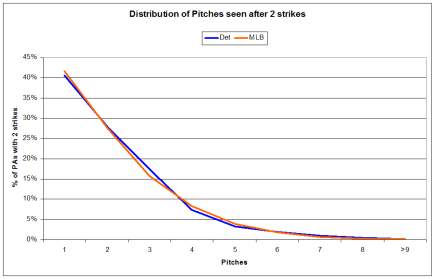Jim Leyland has 2 priorities this season. First he wants to improve baserunning. On that front it seems like he was reading Detroit Tiger Tales’ analysis. His other initiative is improving the Tigers batters approach when they are presented with a two strike count. The Tigers strike out a lot, which means they get to, and struggle with their share of 2 strike counts. But are they really worse than the rest of the league when down in the count?
The following table shows both the Tigers stats when the count reaches 2 strikes, as well as all of MLB in 2006.
Neither group fared well with 2 strikes – which of course isn’t unexpected. And much like all Tigers offensive statistics, this breakdown showed a higher than average slugging percentage, and a sub average OBP, strikeout, and walk rates. The fact that these trends seem to continue in pretty much any hitting count or situation points to it being an all encompassing attribute. Targeting a specific count the change the approach probably won’t have a big impact.
On the other hand, with a 2 strike count being the last stop before a strikeout, it’s as good of place as any to start if your goal is to cut down on the K’s.
Battling
Now everybody loves to see an extended at-bat where a batter shortens up and just works the pitcher until something gives. The guys choke up on the bat and are just trying to make contact. But does this actually help?
The table below shows the results of what happened last year (all teams) the more pitches were seen after the 2nd strike of the at-bat.
It’s true. The longer a batter can hang on the better the results. The OBP goes up, the batting average goes up, the strike out rate goes down.
Now I’ve thought all along that the Tigers problem isn’t striking out, it is not walking enough. But looking at how the walk rate picks up, maybe if the Tigers can learn to battle like the rest of the league they can take care of 2 birds with one stone.
Alas, the Tigers “battle” just as well as anyone else. In fact the distribution of plate appearances and pitches after 2 strikes is pretty much identical to the rest of the league.

Alas, it doesn’t appear to be only a matter of battling. It still comes down to laying off the pitches that are out of the strike zone and getting more free passes.
Tomorrow we’ll take a look at the starting lineup and see who excels in 2 strike situations and who struggles.
UPDATE: For those wishing to see how other teams fared, here are the results for all counts that contained at least 2 strikes:
The information used here was obtained free of charge from and is copyrighted by Retrosheet. Interested parties may contact Retrosheet at “www.retrosheet.org”.
nice job Billfer. Interesting read.
Another nice post. Using facts to illustrate or debunk a theory many of us have — what a concept. Thanks.
By the way, are the differences between DET and MLB above statistically significant?
It would be more interesting if you compared the Tigers to teams who are notorious for taking pitches (like Boston) and then up against a free swinging team (LAA) and see what happens. Comparing to MLB average doesn’t seem as good of analysis since there are teams like Detroit who like to swing and affect what you’re trying to show. The Tigers may be on par with MLB average, but how do they stand vs. the best offenses in the league and how do they compare to teams like them?
To expand (a little) on Ryan’s point, it would be interesting to look at the numbers, say, from teams over .500, or some other index of relative success.
Who wants to bother with subpar teams without some constructive reason?
My best is Inge is near the bottom. With the exception of a couple memorable marathon at-bats last year, he really seems to make it 3 strikes rather quickly. Esp. when given high heat, eye-level kind of stuff.
As for statistically significant, yes. With the sample sizes we are talking about, a 10% difference will hold up statistically all the way out there at the finest bit of the tail.
Vintage Leyland re: Granderson’s strikeouts
http://www.freep.com/apps/pbcs.dll/article?AID=/20070222/SPORTS02/70222029/1048/SPORTS
Sheffy will help, hopefully. Great post.
Offtopic, but what’s gonna happen with Marcus Thames? Seems a waste to keep on the bench for a 200 AB season, though he would be a good weapon.
For those who were curious about what teams were good/bad in these situations I’ve posted that information as well.
My original intention wasn’t to hold the Tigers up to the great offensive teams, but merely to see where they rank in relation to the rest of the league – which is kind of in the middle.
The alerting thing is that low walk rate on the two strike counts. Proving my point exactly! When the Tigers went through that stretch last year when they were like 19-36, the Tigers were exposed, that they don’t know how to work counts.
Then think about how few walks occurred when it was 2-2 or 3-2, what are they doin up there, hacking. I can’t explain it.